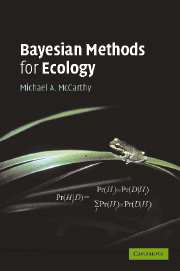6 - Analysis of variance
Published online by Cambridge University Press: 05 June 2012
Summary
In regression analysis, the explanatory variables are usually continuous variables. However, in some of the previous analyses, a categorical variable with two possible values was included. For example, in the analysis of the ant data (Box 5.10), two different habitat types were considered by using the variable ‘habitat’, which takes a value of zero for forests and one for bogs. Similarly, the habitat model for the frog Litoria pearsoniana used a variable that indicated whether palms were present or not. These types of explanatory variables are referred to as factors. The analysis of a variable in response to one or more factors is known as analysis of variance or ANOVA.
It is not my intention to cover all aspects of ANOVA here, but to introduce the most basic elements and then to discuss how some of the more advanced aspects can be included with ease within WinBUGS. More details about using ANOVA in ecology can be found elsewhere (Sokal & Rohlf, 1995; Fowler et al., 1998; Underwood, 1997; Quinn and Keough, 2002). Readers unfamiliar with ANOVA are advised to read these or similar books. In particular, I will not cover much of the theory behind the use of fixed or random factors, repeated measures and interaction terms, but focus on how they can be analysed with Bayesian methods.
- Type
- Chapter
- Information
- Bayesian Methods for Ecology , pp. 158 - 194Publisher: Cambridge University PressPrint publication year: 2007



